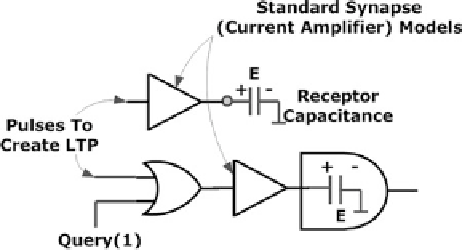Information Technology Reference
In-Depth Information
Trapped static charge across the membrane capacitance of a postsynaptic recep-
tor is equivalent to an initial voltage across the capacitor as depicted in Fig.
3.12
.
Receptor geometry and parameters are assumed to be such that membrane capaci-
tance is a little larger, so that without LTP it cannot be triggered by a single pulse.
But with LTP a single pulse is able to trigger the receptor. LTP makes a receptor
easier to trigger because not as much additional charge is required to build up
capacitive voltage to a threshold for triggering.
For example, the neural gate in the figure can be triggered by a single pulse from
a weak synapse, instead of the usual burst of several pulses. That is, the capacitance
value is such that without LTP, activation would require several pulses, but with
LTP it only requires one pulse.
Unlike ordinary capacitive charge, this charge is trapped and does not readily leak
away via membrane conductance. Hidden in the model are mechanisms that main-
tain a trapped charge. LTP is proposed to achieve elements of long-term memory,
needed in subsequent chapters, although it is not the only proposal for such elements.
Circuit Elements for Back Propagation and Charge Storage
When a smaller diameter dendrite physically connects to a larger diameter dendrite
or soma, there is added membrane capacitance as suggested by the symbol in
Fig.
3.13
. The higher membrane capacitance C can integrate the charges being
delivered by impinging pulses and thus can accumulate voltage. When incoming
pulses have charged the capacitance sufficiently, its voltage reaches a threshold that
triggers an action potential in the larger body.
Fig. 3.12
Synaptic contact
with long-term potentiation
Fig. 3.13
Physical contact to
a larger body


Search WWH ::

Custom Search